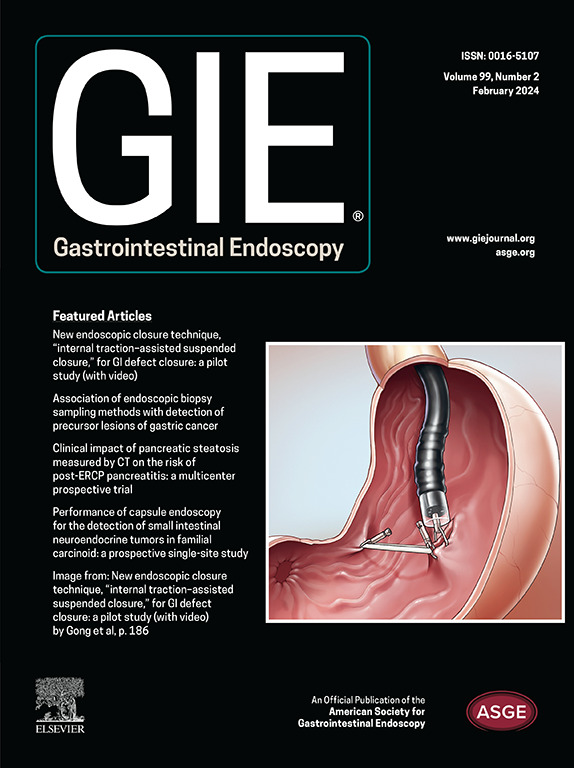水下与传统内镜黏膜下剥离术治疗结直肠病变的 Meta 分析。
IF 6.7
1区 医学
Q1 GASTROENTEROLOGY & HEPATOLOGY
引用次数: 0
摘要
背景和目的:与传统ESD相比,水下内镜黏膜下剥离术(UESD)对临床结果的影响仍不明确。我们对现有数据进行了荟萃分析:我们在在线数据库中搜索了对结肠直肠病变进行 UESD 和 CESD 比较的研究。相关结果包括全切、R0切除、手术时间(分钟)、剥离速度(mm2/分钟)和不良事件。计算了汇总的几率比(OR)、标准化平均差(SMD)以及 95% 的置信区间(CI):共有 7 项研究纳入了 1401 名患者(n=452 名 UESD 患者,n=949 名 CESD 患者)。平均年龄为 69 岁,57% 的患者为男性。UESD 与 CESD 相比,手术时间更短(SMD -1.33, 95% CI -2.34 to -0.32,p = 0.010),解剖速度更快(SMD 1.01, 95% CI 0.35 to 1.68,p = 0.003)。两组患者在全切(OR 1.13,95% CI 0.37 至 3.41)、R0 切除(OR 2.36,95% CI 0.79 至 7.05)、延迟出血(OR 1.34,95% CI 0.65 至 2.74)、穿孔(OR 1.13,95% CI 0.64 至 2.00)和切除后电凝综合征(OR 0.38,95% CI 0.10 至 1.42)方面无明显差异:讨论:与CESD相比,UESD对结直肠病变患者的治疗速度更快,但全切率、R0切除率和不良事件发生率相当。本文章由计算机程序翻译,如有差异,请以英文原文为准。
Underwater versus conventional endoscopic submucosal dissection for colorectal lesions: systematic review and meta-analysis
Background and Aims
Effect of underwater endoscopic submucosal dissection (UESD) on clinical outcomes as compared with conventional ESD (CESD) remains unclear. We conducted a meta-analysis of the available data.
Methods
Online databases were searched for studies comparing UESD with CESD for colorectal lesions. The outcomes of interest were en-bloc resection, R0 resection, procedure time (minutes), dissection speed (mm2/min), and adverse events. Pooled odds ratios (ORs) and standardized mean difference (SMD), along with 95% confidence intervals (CIs) were calculated.
Results
Seven studies with 1401 patients (UESD, 452; CESD, 949) were included. Mean patient age was 69 years, and 57% of patients were men. UESD had both a shorter procedure time (SMD, –1.33; 95% CI, –2.34 to –.32; P = .010) and greater dissection speed (SMD, 1.01; 95% CI, .35-1.68; P = .003) when compared with CESD. No significant differences were observed between the 2 groups with respect to en-bloc resection (OR, 1.13; 95% CI, .37-3.41), R0 resection (OR, 2.36; 95% CI, .79-7.05), delayed bleeding (OR, 1.34; 95% CI, .65-2.74), perforation (OR, 1.13; 95% CI, .64-2.00), and postresection electrocoagulation syndrome (OR, .38; 95% CI, .10-1.42).
Conclusions
UESD was faster in patients with colorectal lesions but had comparable rates of en-bloc resection, R0 resection, and adverse events when compared with CESD.
求助全文
通过发布文献求助,成功后即可免费获取论文全文。
去求助
来源期刊

Gastrointestinal endoscopy
医学-胃肠肝病学
CiteScore
10.30
自引率
7.80%
发文量
1441
审稿时长
38 days
期刊介绍:
Gastrointestinal Endoscopy is a journal publishing original, peer-reviewed articles on endoscopic procedures for studying, diagnosing, and treating digestive diseases. It covers outcomes research, prospective studies, and controlled trials of new endoscopic instruments and treatment methods. The online features include full-text articles, video and audio clips, and MEDLINE links. The journal serves as an international forum for the latest developments in the specialty, offering challenging reports from authorities worldwide. It also publishes abstracts of significant articles from other clinical publications, accompanied by expert commentaries.
 求助内容:
求助内容: 应助结果提醒方式:
应助结果提醒方式:


